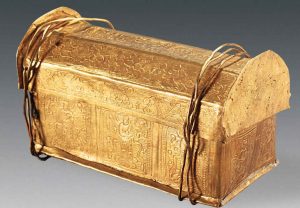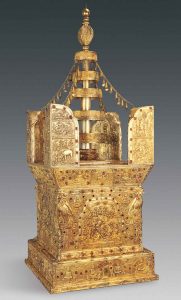A model of a stupa hidden within a stone chest in a crypt beneath a Buddist temple in Nanjing (China) contained a parietal bone of the skull that according to inscriptions belonged to revered Buddha, Siddhartha Gautama himself. The 1000-year-old model was discovered beneath the Grand Bao’en Temple by archaeologists from Nanjing Municipal Institute of Archaeology and was stored within an iron box, which, in turn, was stored within a stone chest (containing images of spirits called apsaras shown playing musical instruments). The model is made of sandalwood, silver and gold, and is covered with gemstones made of crystal, glass, agate and lapis lazuli.

The parietal bone of the Buddha was buried within an inner casket made of gold, which, in turn, was placed in an outer casket made of silver (both decorated with images of lotus patterns, phoenix birds and gods guarding the caskets with swords), according to the archaeologists. The silver casket was then placed inside the model of the stupa.

The bone was placed along with three crystal bottles and a silver box, all of which contain the remains of other Buddhist saints. The discovery was made during excavations carried out between 2007-2010 but the results and the discovery was reported in the journal Wenwu in 2015 before being translated and published in Chinese Cultural Relics journal. Inscriptions date the stone chest to the reign of Emperor Zhenzong (997-1022 AD), during the Song Dynasty. Inscriptions on the stupa also mention names of people who donated money and material to build the model, as well as some of the people who constructed it. The Buddha’s parietal bone and other artefacts from the excavation were displayed in Hong Kong and Macao and afterwards the remains were interred in the modern-day Qixia Temple by Buddhist monks.
(after Live Science)